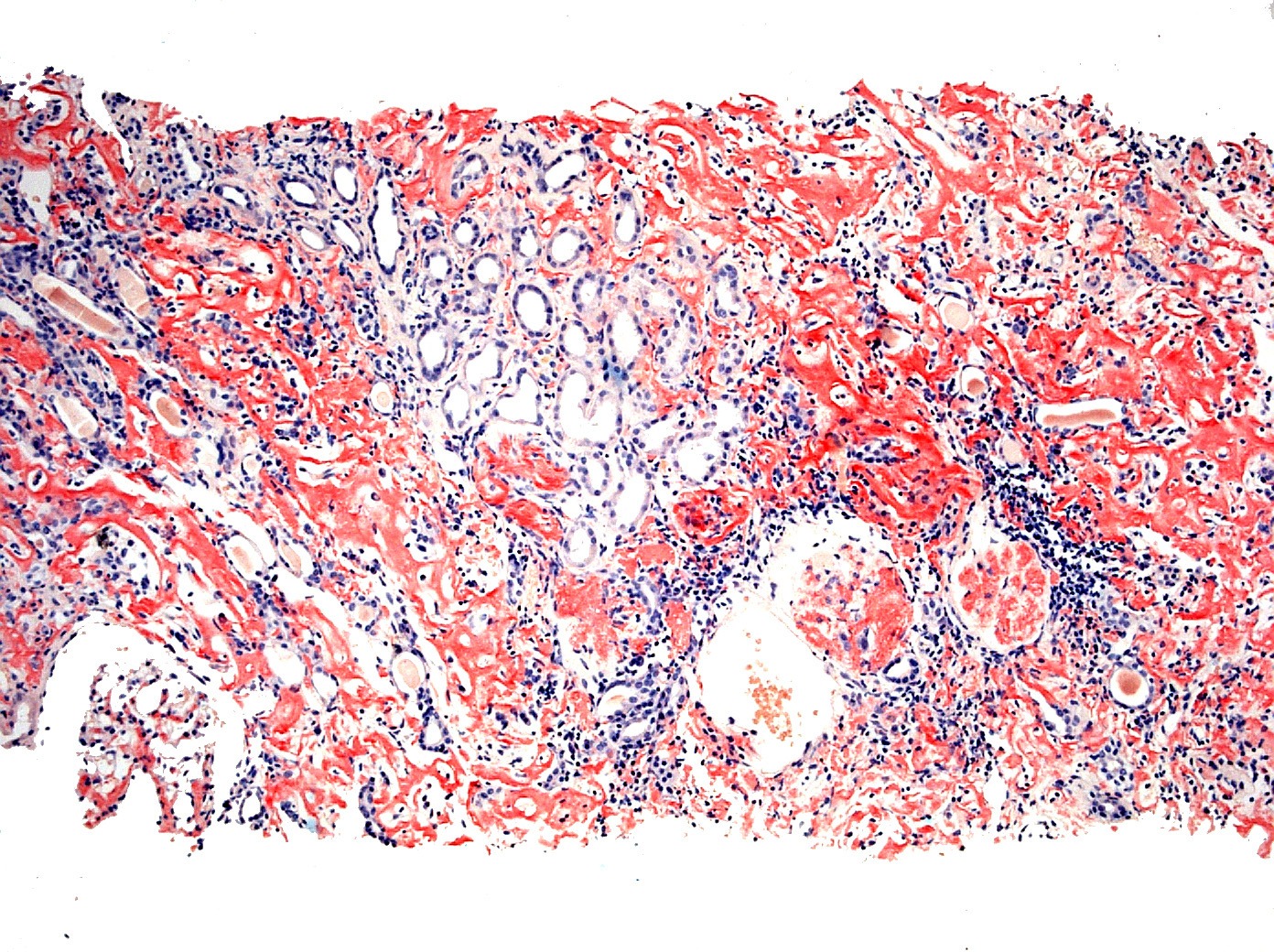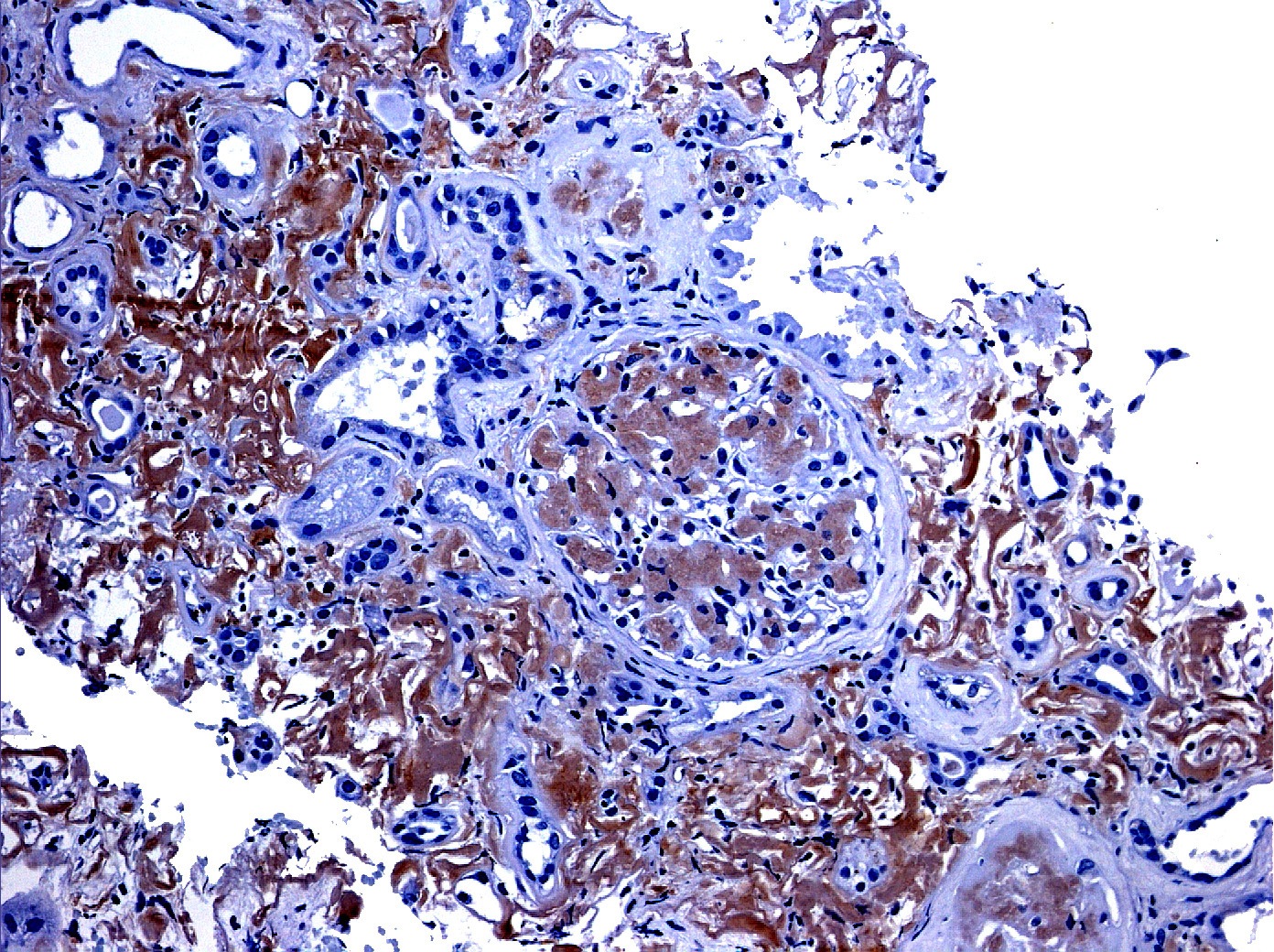Photomicrographs show extensive interstitial and glomerular deposition of Congo red positive material that stains positive for LECT2. Despite being one of the most recently described amyloid proteins, amyloid composed of leukocyte chemotactic factor 2 (ALECT2) is actually quite prevalent. Two large case series focusing on renal amyloidosis have identified ALECT2 as one of the most common forms of amyloidosis involving the kidney along with AL and AA amyloid.1-4 Additionally, a large case series in the liver identified it as the second most common form of hepatic amyloidosis.5 The vast majority of patients suffering from this disease in the United States are of Hispanic ethnicity.3,4 In fact, LECT2 represents the most common form of amyloidosis among Hispanics in the southwest United States, representing more than 50% of cases.3 Our investigations into the prevalence of ALECT2 in the southwest United States through an autopsy study have shown that 3.1% of decedents of Hispanic ethnicity from this region show ALECT2 deposition within kidney parenchyma. There are other ethnicities affected by this disease, including Egyptians, Sudanese, Punjabis, and First Nations people indigenous to Northern British Columbia, Canada.6-9 Conversely, there are also ethnicities in which the disease appears to be completely absent. For example, in the recent case series of ALECT2 from the National Amyloid Center in the United Kingdom, 67% of ALECT2 patients were from the Indian subcontinent (India and Pakistan), 30% of Middle Eastern ancestry (Egyptian and Sudanese) and 3% of Mexican origin. Despite being the most common ethnicity treated at this institution, ALECT2 amyloidosis was not diagnosed in a single British Caucasians during the study period (1994-2015) when a total of 6739 patients were treated.9 Similarly, our laboratory processes over 3000 renal biopsies from African American patients annually and we have yet to identify a single case of ALECT2 in this population (unpublished data).
1. Larsen CP, Walker PD, Weiss DT, et al. Prevalence and morphology of leukocyte chemotactic factor 2-associated amyloid in renal biopsies. Kidney Int 2010; 77: 816-819.
2. Said SM, Sethi S, Cornell LD, et al. Renal amyloidosis: origin and pathology of 445 recent cases from a single center. Mod Pathol 2012; 25: 404A.
3. Larsen CP, Kossmann RJ, Beggs ML, et al. Clinical, morphologic, and genetic features of renal leukocyte chemotactic factor 2 amyloidosis. Kidney Int 2014; 86: 378-382.
4. Said SM, Sethi S, Valerie AM, et al. Characterization and outcomes of renal leukocyte chemotactic factor 2-associated amyloidosis. Kidney Int 2014; 86: 370-377.
5. Mereuta OM, Theis JD, Vrana JA, et al. Leukocyte cell-derived chemotaxin 2 (LECT2)-associated amyloidosis is a frequent cause of hepatic amyloidosis in the United States. Blood 2014; 123: 1479-1482.
6. Dogan A, Theis JD, Vrana JA. Clinical and pathological phenotype of leukocyte cell-derived chemotaxin-2 (LECT2) amyloidosis (ALECT2). Amyloid Journal of Protein Folding Disorders 2010; 17: 69-70.
7. Larsen CP, Ismail W, Kurtin PJ, et al. Leukocyte chemotactic factor 2 amyloidosis (ALECT2) is a common form of renal amyloidosis among Egyptians. Mod Pathol 2016; 29: 416-420.
8. Hutton HL, DeMarco ML, Magil AB, et al. Renal leukocyte chemotactic factor 2 (LECT2) amyloidosis in First Nations people in northern British Columbia, Canada: a report of 4 cases. Am J Kidney Dis 2014; 64: 790-792.
9. Rezk T, Gilbertson JA, Rowczenio D, et al. Diagnosis, pathogenesis and outcome in leucocyte chemotactic factor 2 (ALECT2) amyloidosis. Nephrol Dial Transplant 2016.
Quick note: This post is to be used for informational purposes only and does not constitute medical or health advice. Each person should consult their own doctor with respect to matters referenced. Arkana Laboratories assumes no liability for actions taken in reliance upon the information contained herein.




